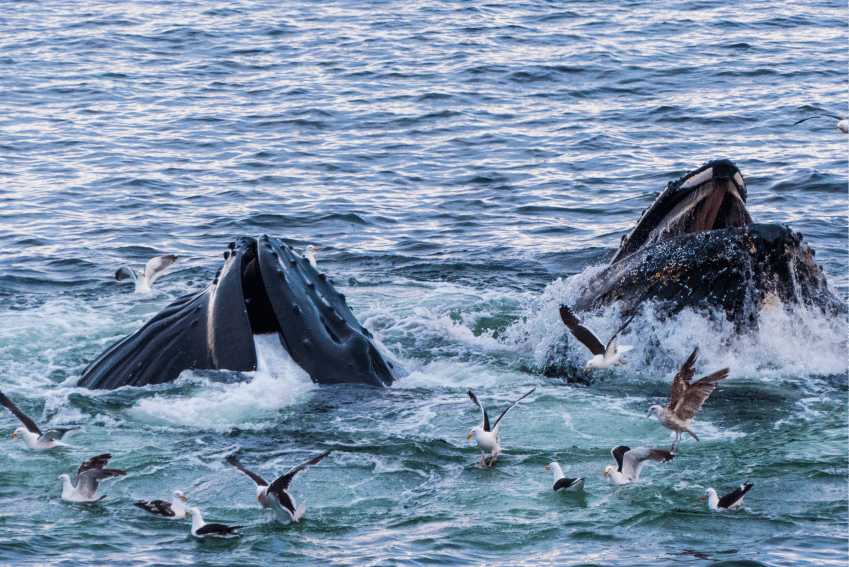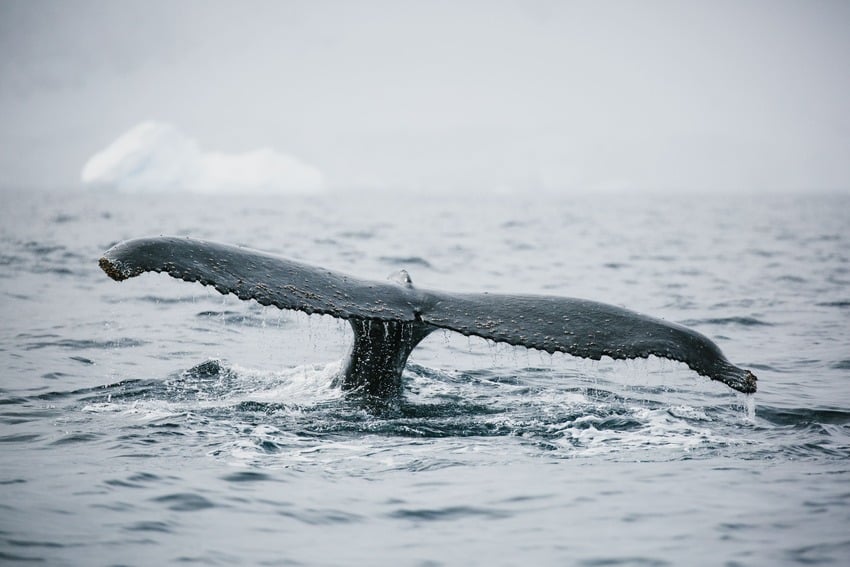Svalbard Whale Watching
It’s one of the most remote gems of the High Arctic and a must-visit for any explorer and wildlife enthusiast! At only around a 1,000 km (650 miles) south of the North Pole, the Svalbard archipelago features snow-capped mountains, incredible glaciers, fjords and icebergs. Once you see the unique and rugged landscapes of the archipelago, it’s hard not to fall in love with this place. Although it’s so far north, there is plenty of wildlife to see like Svalbard reindeer, ringed seals, polar bears and Arctic foxes, and of course…Svalbard whales!
Ready for an epic Svalbard whale watching expedition? Come aboard an expedition cruise, see the whales of Svalbard and discover why the archipelago is a dream come true for real adventurers.

When is the Best Time to Watch Whales in Svalbard?
If you’re looking for an unforgettable whale watching adventure, you should visit during the Arctic summer. May to September is the best season for whale watching in Svalbard. At that time sea ice recedes, and the waters around the archipelago are rich with fish and Arctic krill. Whales just love a good feast! During the Arctic winter months, whales are moving south toward the krill-rich Antarctic waters. With 24 hours of daylight during the Arctic summer, you’ll have plenty of time to look and the best way to see them is by booking a Svalbard cruise. From the deck you can observe them going about their business in the Arctic waters and enjoy these majestic giants in their natural environment.
What whale species can you see in Svalbard?
As a wildlife lover, you’ll be amazed by the different species you can spot on your Svalbard whale watching trip.
-
Blue whales
-
Humpback whales
-
Minke whales
-
Beluga whales
-
Sperm whales
-
Northern bottlenose whales
-
Fin whales
-
Bowhead whales
Apart from these iconic Svalbard whales, you may also spot species from the dolphin family such as beaked dolphins, killer whales (orcas) and pilot whales.

6 Whale Species For Watching in Svalbard
Find out about our personal favorites among Svalbard whales to spot on an expedition cruise to the archipelago:
1. Beluga Whale
Also known as the white whale, the beluga is probably the most recognizable of all Arctic whales. An adult reaches a length of around 3-5 meters (10-16 feet) with a weight of 500-1,500kg (1,100-3,300 lbs.) and features a creamy-white color with a distinctive melon (an echolocation organ) on its broad head. These toothed whales often travel in groups and are commonly spotted along the coasts of Svalbard. Their diet consists of fish and marine invertebrates, which they hunt by using echolocation. Belugas are also one of the most vocal whales and are often called the canaries of the seas because of their bird-like singing.
2. Humpback Whale
Humpbacks migrate from tropical breeding areas to Svalbard in the summer months to feed on fish and plankton. As a member of the baleen whale family, they feature expanding throats that help them gulp up large quantities of water. Their baleen plates filter out food while the water is expelled through them. Unlike toothed whales, humpbacks use their voices for communication instead of locating prey. Adults can be dark gray, or black with white patches on the underside and tail flukes. Their small dorsal fin is located on a distinctive hump, which appears prominently when the whale arches its back before getting ready for a deep dive.
Humpbacks can reach around 11-18 meters (36-60 feet) in length and can weigh up to 45 kilotons. These whales exhibit remarkable behaviors such as spy hopping, lob-tailing, fin waving and breaching (jumping out of the water), which is a delight for observers! Around Svalbard, humpbacks are known to engage in collective hunting strategies, such as herding a shoal of fish and then engulfing them spectacularly at the surface.
3. Blue whale
The blue whale is the largest animal to have ever lived. A fully-grown blue whale reaches around 22-31 meters (72-102 feet) in length and up to 140 kilotons in mass. You’ll easily recognize it by its long body and mottled bluish-gray coloration. The falcate dorsal fin is relatively small and positioned very far back on the body.
Younger blue whales are sometimes confused with fin whales, which can also be spotted around Svalbard. Like the humpback, the blue whale is a rorqual and feeds on fish and plankton. You can spot them in Svalbard’s deep waters, often at the edge of the continental shelf where food is concentrated by upwelling of currents.
4. Bowhead Whale
The bowhead whale (originally known as the Greenland right whale) is a true Arctic specialist with a body designed for breaking through Arctic sea ice up to 60cm (24 inches) thick. The massive head, with its huge bow-shaped mouth, makes up to 35-40% of the animal’s total length. Adults reach around 15-18.5 meters (49-60 feet) in length, 60-100 kilotons in weight and have extremely rotund black bodies with no dorsal fin. They have a white lower lip with a distinctive line of black spots. They are baleen whales, which feed by sieving food from the water as they slowly swim through it with mouths agape.
Studies show that bowheads are among the longest-living animals, with a life expectancy of up to 200 years. Once hunted almost to extinction, you can spot small groups of them around the Barents Sea, between Svalbard and Franz Josef Land. Look out for their characteristic V-shaped blows!
5. Fin Whale
Fins belong to the baleen whale family and are the second largest after the blue whales. They can reach a length of 26 meters (85 feet) and a weigh up to 81 kilotons. Fin whales feature a slender body with brownish-gray colors and a pale underside. Their life expectancy is up to 100 years. During the summer months, you can see them in the waters and fjords around Svalbard, especially on the western coasts, where the continental shelf drops into the deep-sea basin. Fin whales prefer to stay in smaller groups, but you can spot both single whales and larger groups. Like the blue whales, they feature baleen plates and feed by gulping up mouthfuls of water to get to their food.
6. Minke Whale
At only about 10 meters (33 feet) in length, the minke is the smallest baleen whale. It features a slim body, dark-grey to black colors and a pale underside. Its dorsal fin resembles a sickle and is at the beginning of the last third of its body. Its diet in the Arctic waters consists of small fish and plankton, which are filtered by large baleen plates. Minke whales can live up to 50 years.
Spotting minke whales is a bit of a challenge, as they are not that common in Svalbard and do not spend much time at the surface. You may catch a glimpse at the moment it surfaces…before it dives back down again.